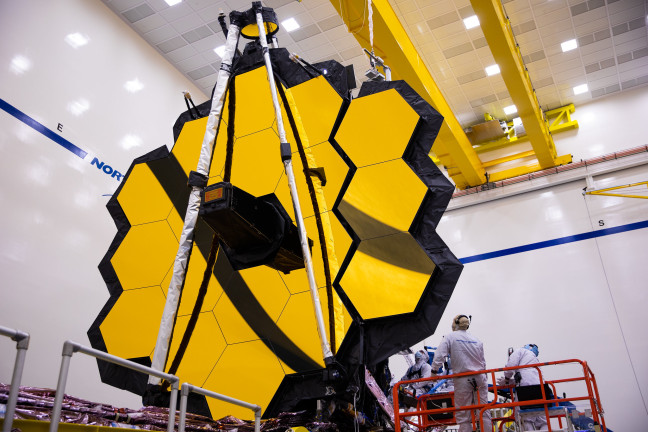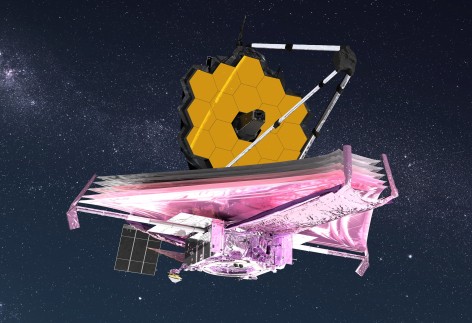
Test teams deploy the James Webb Space Telescope's 21.3-foot, 18-section, gold-coated mirror as they prepare for the mission's launch. The instrument was carried into space Dec. 25, 2021, folded and stowed aboard an Ariane 5 rocket from Europe’s Spaceport in French Guiana, South America. The telescope is a joint effort of NASA, the European Space Agency and the Canadian Space Agency. Larger photo. Photo by Northrop Grumman, courtesy of NASA.
AMES, Iowa – Iowa State University’s Massimo Marengo recited some of the engineering challenges of successfully unfolding and deploying the recently launched James Webb Space Telescope (JWST):
- “There were more than 300 single-point-of-failure items that could go wrong – it needed to work perfectly.”
- If, say, the 50 major deployments and 178 release mechanisms didn’t work perfectly, there’s no way to go up and fix the problems. Space Shuttle astronauts made five house calls to the Hubble Space Telescope between 1993 and 2009 for various repairs. “With JWTS, that’s not possible – it’s significantly farther than the orbit of the moon.”
- It’s, in fact, about a million miles from Earth, orbiting the sun from a point in space known as L2 (the second Lagrange point) where the telescope is suspended between the gravitational pulls of the Earth and sun. That suspension means the telescope doesn’t have to burn much fuel to maintain its orbit. That location also keeps the space telescope in line with Earth as it moves around the sun, allowing its five-layer sunshield (it’s nearly the size of three tennis courts) to protect the telescope from the light and heat of the Earth, sun and moon. “Earth is too bright. Being closer would be like observing the sky without turning off the lights.”
All in all, “It’s a very complex instrument,” said Marengo, an Iowa State professor of physics and astronomy. “We’ve never done anything like this before.”
Answers blowing in the cosmic dust
Marengo is a veteran of using data from infrared space telescopes to study dusty corners of the universe to learn more about the evolution of stars and galaxies.
He’s studied data collected by the Spitzer Space Telescope, launched in 2003, and its 33.5-inch diameter telescope. He, for example, has used Spitzer to study how tight double-star systems could be efficient “destroyers of worlds” because planet collisions may be common within the systems.
But it’s about to be a whole new dataset.
JWST has a 21.3-foot, 18-section, gold-coated mirror. It’s designed to be powerful and sensitive, taking infrared images of the most distant and therefore earliest stars and galaxies.
And, because it works at infrared wavelengths, it can see through clouds of dust where stars and planets form and evolve. That’s a big deal to Marengo and the other members of a research collaboration led by Martha Boyer of the Space Telescope Science Institute based in Baltimore.
The collaboration is gearing up to study a nearby dwarf galaxy (known as Sextans A) with two of Webb’s instruments, the Near Infrared Camera and the Mid Infrared Instrument. They want to investigate what kind of dust forms in the “primitive environment” of this galaxy, which resembles the conditions of the early universe. Before Webb, instruments weren’t sensitive enough to answer questions about the mineralogy, grain properties or the quantity of this extremely metal-poor dust.
The Webb data will help the astronomers understand the “galactic ecosystem” of primitive dust forming stars that evolve and then release dust back into space, Marengo said. It’s basically figuring out the early steps in “the cycle of life of the universe.”
“If we want to understand how galaxies and stars evolve,” he said, “we need to figure out the details of how dust is formed by different stars and what happens when they release dust back into the interstellar medium.”
Mixing old and new is hard to do
As astronomers wait for infrared images from Webb, Marengo has worked with a team led by Kate Su of the University of Arizona to develop a way to cross calibrate old data from Spitzer with new data from Webb.
If astronomers don’t do that, Marengo said it would be like taking measurements with different rulers marking different scales.
But that cross calibration isn’t easy. The stars used to calibrate Spitzer are too bright for Webb; the stars used to calibrate Webb are too faint for Spitzer. So Marengo led an effort to establish a technique that allows astronomers to measure the brightness of very bright stars, even if their images are overexposed. That technique can bridge the gap in the calibration of the two telescopes.
Details of the technique have recently been reported in a paper published by The Astronomical Journal.
Just a little longer …
JWST has been in the works since 1996, but has continuously run into delays, budget troubles and, lately, the pandemic. Now that it’s unfolded and at its working orbit, it still needs to cool to about -400 Fahrenheit (its cold side behind the sunshield is already down to -381) and its 18 hexagon-shaped mirrors need to be precisely aligned.
That should be accomplished by summer. Then new data should start flowing into astronomers’ computers.
“It will be a game changer,” Marengo said. “The kind of science we can do isn’t anything we could do before.”
The most exciting part, he said, is the expectation that JWST will lead to new astronomy.
“I’m sure there will be surprises,” he said. “We’ll be surprised by discoveries we had no idea about when JWST was designed.”
